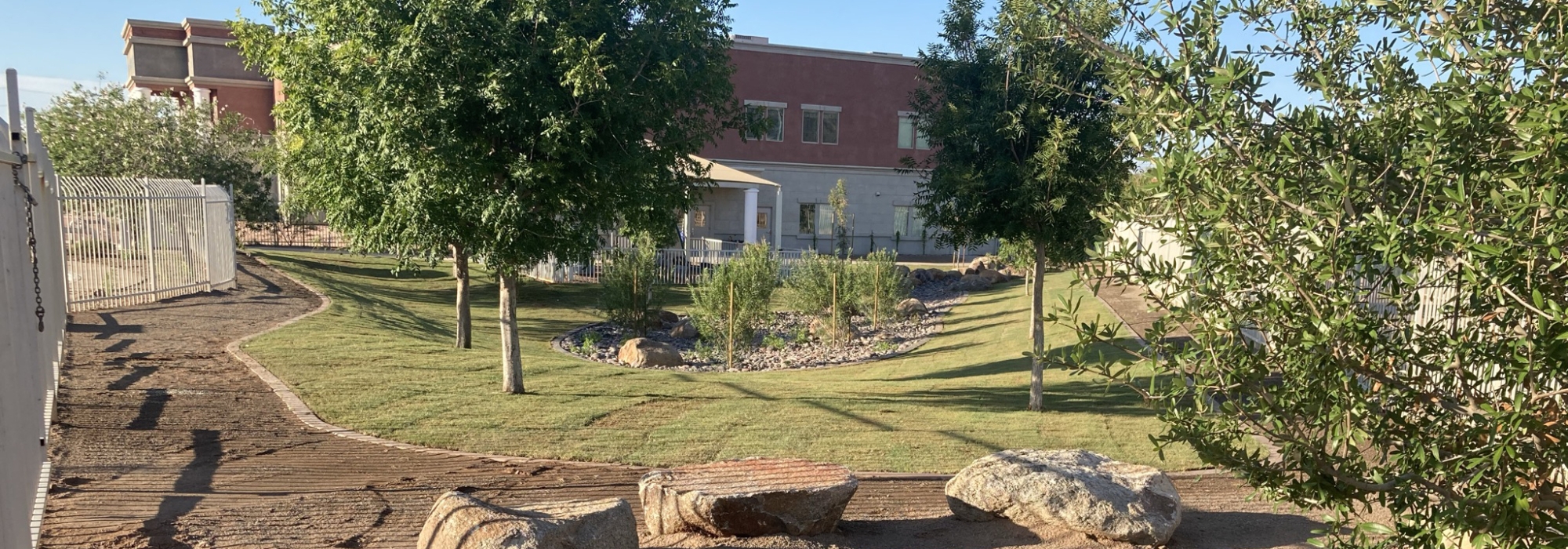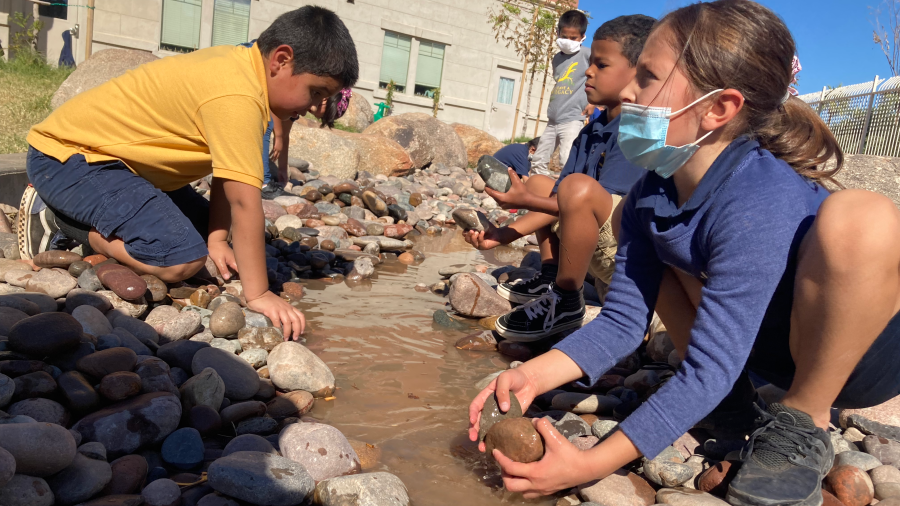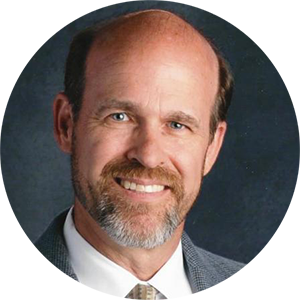
How does exposure to nature impact school and community wellbeing?
Brian Winsor, Paideia Academies
“This project is an example to all schools of what their outdoor spaces could be — protecting health, supporting well-being and learning, and being used for much more of the school day!”
- ASU team member
Background
Children in urban school settings where heat and poor air quality are prevalent are increasingly unsafe in outdoor environments. Many urban desert schools have concrete, gravel and dirt playgrounds with metal or plastic equipment that is highly unsafe during most of the desert months. These conditions strain not only the physical health but the social and emotional health of the child from the scarcity of playspace and equipment. Furthermore, these unsafe conditions prevent students from benefiting from exposure to nature and increased social cohesion that such places offer.
Maricopa County is not only one of the fastest growing metro areas of the U.S. — accompanied by a rise in poor air quality — but it is also located in a desert environment experiencing record-breaking heat in recent years.
Rapidly sprawling housing and accompanying industrial developments are contributing to the disappearance of natural landscapes, an increase of unsafe outdoor temperatures and a decrease of air quality, making it unsafe to be outside for much of the year.
Yet ample research has identified a linkage between exposure to nature and its positive physical, mental and emotional health on school children. Researchers have further linked urban green spaces to prosocial behaviors that cultivate social cohesion in ways that increase a sense of social wellbeing. In a holistic sense, the natural environment and the social environment are intricately entwined, and critical for learners.
Research questions
-
How can outdoor learning spaces be redesigned in an urban desert environment to mitigate heat and air quality and safely recover the social and health benefits of exposure to nature?
-
In particular, what is the relationship between exposure to a carefully designed urban nature-scape and social health outcomes on a school community?
Methods and findings
In 2018, Winsor partnered with Dr. Jennifer Vanos, assistant professor in ASU's School of Sustainability, to launch a project to completely re-naturalize the outdoor spaces of the Paideia campuses to determine the long-term impact of heat and air quality on the physical health of the school community. This project expands the study beyond physical health to the social/emotional and educational wellbeing of the school and local community. The first phase of the redesign was completed in summer of 2021 with the school community returning to campus in August.
For his fellowship, Winsor launched a longitudinal study to determine the long-term impact of frequent childhood exposure to nature on the overall sense of wellbeing of a school community. The design of the study analyzes elements of a safe urban naturescape in an urban school setting to determine the specific relationship between (a) nature-dose, characterized by type of naturescape, frequency and duration of use and type of engagement; and (b) physical activity; (c) social connectedness; and (d) academic engagement and (e) overall sense of wellbeing within a school community for students, teachers, staff, and parents or guardians.
Partners
Paideia Academies, Inc.
ASU
-
Dr. Vanos, School of Sustainability
-
Dr. Zuicker, Mary Lou Fulton College of Education
-
Dr. Cheng and Dr. Coseo, The Design School
-
Dr. Ross, College of Health Solutions
-
Dr. Hess, College of Integrative Sciences and Arts
Trees Matter
Impact
Prior to the re-naturalization of Paideia’s outdoor spaces, recess activity was contained mostly to the north concrete courts and dirt playground area. No students played in the south playground area. This resulted in high congestion of students on the courts and dirt playground. This condition of highly congested play areas created a sense of scarcity and competition for not only play equipment and play space but also for social connections. Many students spent more time standing in line to play a court or field game than they did in physical or social activity. During high heat days students huddled under shade trees, adding to the sense of scarcity and competition for these resources. A typical lunch recess resulted in incidents of angry interactions, minor fall injuries and student competition for social connections.
The redesign of the campus included trees, many large boulders in two bioswales, gardens, pollinator plants, hedges surrounding the campus, cooling vines on trellises and the walls, outdoor eating and learning spaces and a water feature. The impact of the naturespace investment was not immediate. We found that the students remained mostly in the old habits of court games and soccer in the north dirt field. We discovered that the students had to be taught how to play and interact within natural spaces. Winsor spent time every morning for several days in the South Forest playing with the students. He demonstrated how to hop from boulder to boulder, how to run on a nature path, how to climb in the climbing zone and how to make a river with the water feature. As a result of showing the students how to interact with the many features of Paideia naturescape, the students now are spread throughout the outdoor campus interacting with nature and one another.
A blossoming impact of this project is the re-imagining of “recess”. In a typical school, recess is a period of time when the teacher is relieved of the students and the students have 15 minutes to “get the wiggles out”. Winsor is finding that in a nature-centric paradigm, recess is whenever the teacher and students want to be outside to freely experience nature, to engage in academic activities in the gardens, under a tree or on a boulder, to meditate or just to be together. He and his team have found that this re-imagining of the “playground” is increasing physical activity, social connectedness and a sense of overall wellbeing in our school community.
Deliverables
Winsor oversaw the installation of the Paideia nature-scape and captured drone pictures before and after the campus's transformation. He also captured weekly student surveys to understand where in the naturespace they spent time, their level of physical engagement while in the naturespace, what they liked to do most in the naturespace, and their level of social connectedness at Paideia. Finally, he created an annual community wellbeing survey to explore community members’, Paideia employees’ and parents’ perceptions of nature-based learning and their self-reported level of wellbeing as COVID-19 continues to impact lives.
Brian Winsor
Founder & President
Paideia Academies, Inc.
Community Fellow, 2021
Dr. Brian Winsor, founder of Paideia Academies, has been an educator for over 30 years. He has a bachelor’s degree in history, a master’s degree in special education, and a doctorate degree in educational leadership. He is a 2021 ASU KER Fellow (Knowledge Exchange for Resiliency). He has been an avid outdoorsman enjoying long-range backpacking and scuba diving.
Brian began his education career as a junior high school teacher of students with learning disabilities and behavior/emotional disorders. He has been an elementary school principal, consultant for schools on leadership, curriculum, instructional strategies, as well as academic and behavior intervention and frequent presenter of educational leadership at national conferences.
Throughout his years as a special educator, principal and consultant, Brian developed into a fierce advocate for whole-person education. The notion that a child's worth could be defined by a standardized test fueled his determination to develop a school that valued the whole person - body, mind, heart and spirit. In 2011, Brian along with a select group of colleagues and community members created Paideia Academies Inc. In August of 2012, he opened Paideia Academy South Phoenix in a beautiful new building designed specifically for the community of South Phoenix. Over the following 10 years, the whole-person mission of Paideia has expanded to community partners including several colleges and professors from Arizona State University.
Brian has a deep connection to nature. He has been an avid long-range backpacker spending weeks at a time hiking through the mountains of California and the northwest. His love for and acknowledgement of the healing power of nature has influenced the mission and vision of Paideia Academies. Brian is currently engaged in reconstructing the Paideia Academy South Phoenix campus into an urban forest nature-scape. The redesign includes increased number of native trees, shrubbery and flowering vegetation as well as two bioswales with giant boulders and native vegetation. In conjunction with the nature redesign of the campus, Brian has organized a collaborative team of Paideia educators and ASU researchers to research the impact of nature-dose on the overall sense of wellbeing of the Paideia community. The nature-scape redesign project is the foundation of Brian's KER (Knowledge Exchange for Resiliency) project.



